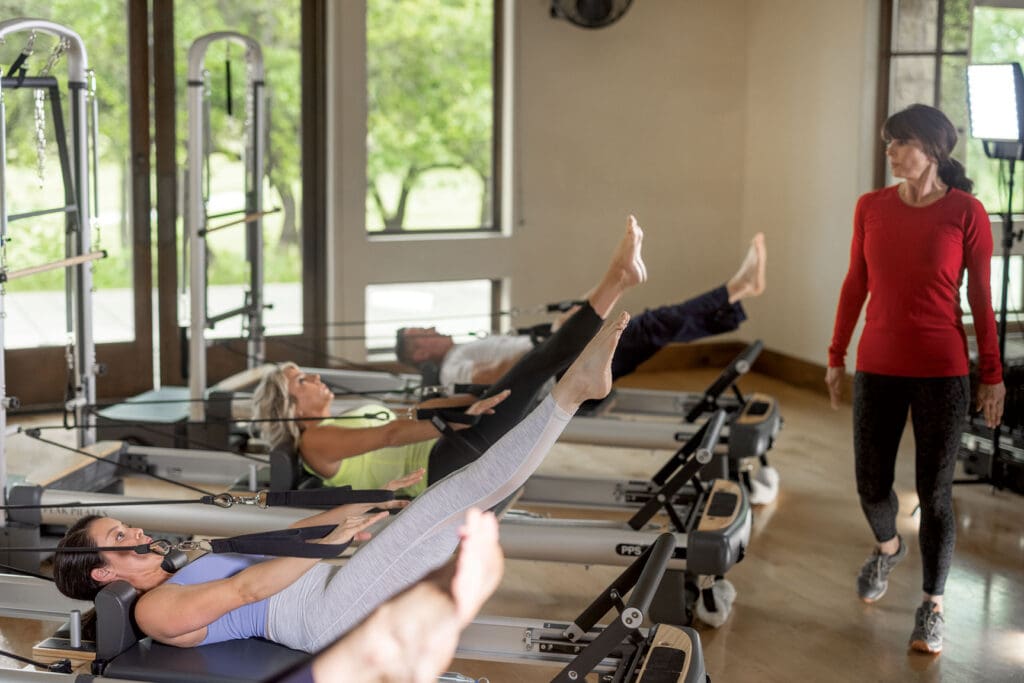This week I got a ping on my phone from a friend doing battle with some ongoing low back pain. After consulting with a physician and completing physical therapy, my friend was advised to incorporate more “glute and core” exercises into workouts. Being a resourceful person, my friend googled “glute exercises” then forwarded a link to me with these words: “need to work on isolating my glutes, what do you think about these exercises?” My brain immediately and automatically shifted into teacher mode. I had only one thought: Isolate? Please don’t let your glutes work out alone!
As a Pilates instructor and a human who has surpassed the half way point in her life, I know that isolating one muscle to create strength comes at a cost. Without help from another muscle group, things can and will go very wrong. I also know that my friend’s mission to strengthen the glutes was well intended. It was the idea of solely focusing on one very specific area without regard to another that raised my concern.
Many years ago, when I first started my own Pilates practice, I was struck by how different my body felt moving in a Pilates class versus how it felt in my usual group classes. The biggest difference in my Pilates class was that every single exercise called upon my body to shift what part of me was moving and what part stayed stable — with a very strong emphasis on the stability part. I had no idea how incorporating both mobility and stability in every single move would change how I work out, how I ski, how I hike mountains with my family and how I move through life. In fact, it is safe to say that before I was introduced to Pilates, I had very little awareness of mobility and stability and how that pertains to my body as an entire movement system.
The Merriam-Webster dictionary defines “united” as 1. made one; combined, 2. relating to or produced by joint action, 3. being in agreement; harmonious. Thank you, dictionary people. I cannot think of a better adjective to describe the perfect Pilates workout. It is the body working in a united state — using both mobility and stability in each exercise, providing an effective and efficient workout.
Pilates is a whole-body exercise program. We don’t just emphasize one body part. We address the entire system and how it works together for optimal benefits and better movement! What does that mean? In the context of movement, let’s break it down with a general definition of mobility and stability. Skeletal muscle tissues can hold things together or move parts relative to each other; both parts are equally important. Mobility refers to the ability of a joint to move freely through a certain range of motion without restriction from the surrounding tissues. The stability aspect refers to the ability to recruit the muscles around the joint in order to prevent movement. It is the constant shift between the two that helps us to gain strength and prevent injury. Both are equally important!
Many of the most common injuries and complaints that I see and hear begin with problems in assigning the right muscle to the right job. An example of how the synergistic body parts work together is walking. Ideally, the large glute muscles are used along with their connectors from the pelvis to the hip to push the leg forward (mobilizing) as it lifts off the ground while keeping your spine upright (stabilizing.) Pro tip: if you’re shuffling your feet when you are walking, please wake up your glutes and tell them to get to work.
Still unsure if your muscles are doing their job correctly? Let’s meet! In a one-hour Pilates session, you will move through a series of exercises created to highlight both mobility AND stability. We know that systems work best in unison; our bodies are no exception. The human body is designed to move, and efficient movement involves numerous muscles and joints working together simultaneously. Limitations in either of these areas leads to compensation somewhere in the system creating faulty movement patterns and increased risk of injury. This is a very common occurrence and happens to most people at some point in their life (myself included!). If you’ve already experienced an injury, don’t worry. Once you’ve been given clearance to exercise, Pilates will meet you where you are. With the right guidance, consistency and commitment, new and healthier movement patterns can be created. Pilates is here for that and I am, too. I can’t promise you six pack abs or that doing “these four glute exercises will erase your back pain!” And in the continued interest of full disclosure, I am known to lose track of counting repetitions. But I can promise that I will be tracking your form and movement. That is my priority. I can also promise that in Pilates, we will work together in a united effort to improve the way you move. By moving and working together, we are stronger!
Kris Cracknell is the Pilates Instructor at The Clubs of Cordillera Ranch. She can be reached at pilates@cordilleraranch.com or 210.860.7322.







